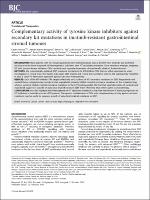Complementary activity of tyrosine kinase inhibitors against secondary kit mutations in imatinib-resistant gastrointestinal stromal tumours
Autor
Fecha
2019-03Enlace permanente
https://hdl.handle.net/11351/5770DOI
10.1038/s41416-019-0389-6
ISSN
1532-1827
WOS
000461700900007
PMID
30792533
Palabras clave
Marcadores predictivos; Sarcoma; Tumores del estroma gastrointestinalCitación recomendada
Serrano C, Mariño-Enríquez A, Tao DL, Ketzer J, Eilers G, Zhu M, et al. Complementary activity of tyrosine kinase inhibitors against secondary kit mutations in imatinib-resistant gastrointestinal stromal tumours. Br J Cancer. 2019 Mar;120(6):612–20.
Audiencia
Professionals
Este elemento aparece en las siguientes colecciones
- HVH - Articles científics [4476]
- VHIO - Articles científics [1250]
El ítem tiene asociados los siguientes ficheros de licencia:

 Área privada
Área privada Contacto
Contacto







